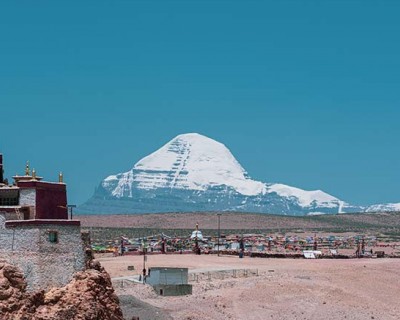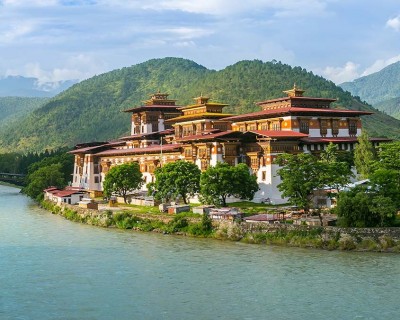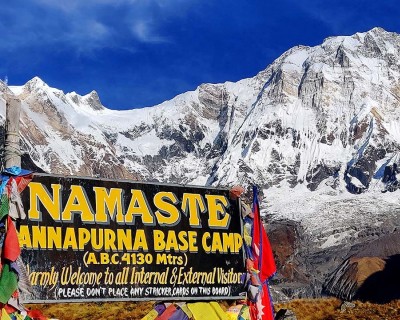There are various viewpoints along the route, including Kalapathar, where you can observe Mt. Everest from a close range. Furthermore, there are green forest regions and green vegetation in these trails to EBC. The rare and endangered wildlife in the Sagarmatha National Park is quite appealing in May. Himalayan Tahr, red panda, yaks, snow leopards, danfe, musk deers are some of the animals you can find along the trail.
Additionally, the Sherpas settlements of the Everest region are unique and culturally significant. There are ancient monasteries, gompas, chortens, prayer flags, prayer wheels, and other Buddhist monuments. Read further for the Everest Base Camp Trek in May package details. Happy Travels!
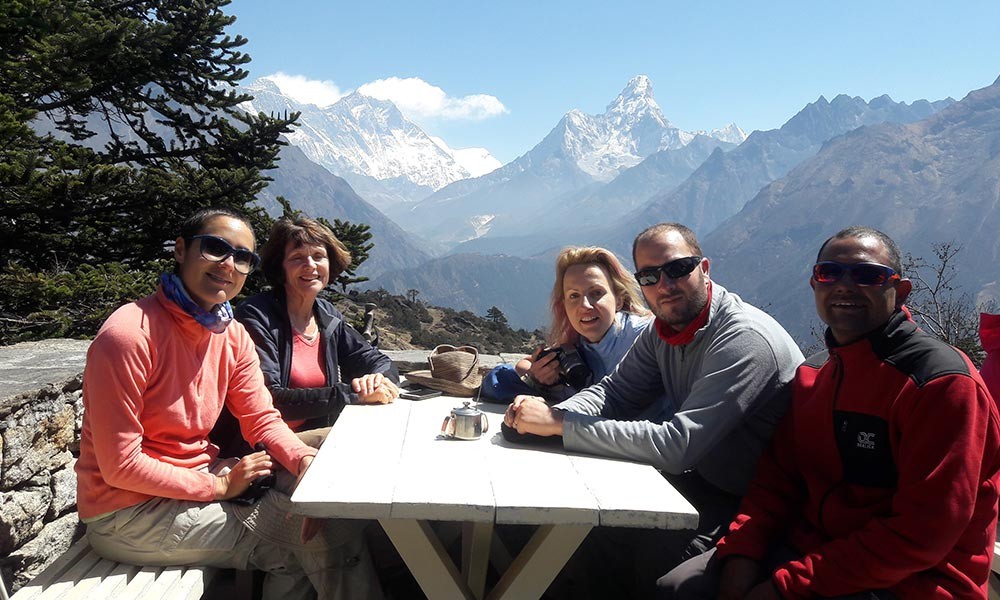
Check our group joining EBC trek package.
Trip Highlights
- Awe-inspiring snow-clad Himalayan mountains of the Everest Mahalangur region, including Mt. Everest, Mt Ama Dablam, Lhotse, Nuptse, Cho Oyu, and others
- Majestic views of Himalayan sunrise and sunsets from various points along the trail, including Kalapathar
- Trekking through the challenging landscapes of the region
- Incredible natural beauties of the area including hills, waterfalls, glaciers, rivers, lakes, and others
- Experiencing the vibrant atmosphere of the Everest Base Camp
- Exploring the cultural trails of the site, including ancient monasteries, gompas, chortens, and local settlements
- Outstanding stay at local tea houses and tasting the delicious cuisine
- The incredible hospitality of the local people
Weather Conditions in May
May is the Spring season in the Himalayan foothills of Nepal. Trekkers will experience perfect weather during this month. However, there might be some early monsoon rainfall in the latter parts of the month. Hence, the early parts of May is possibly the best time for the trek.
However, the high-altitude region has unpredictable weather conditions. The weather conditions in the area can change quickly. There can be overcast conditions from warm sunny days in a few hours. You will trek through dry and sunny trails with warm conditions.
But as you move higher, you can experience a decrease in temperature. Hence, you should wear proper warm clothes to tackle these cold conditions in the Himalayas. The nighttime temperatures can drop around 0°C or below, while daytime temperatures can range around 15°C. The temperature will gradually decrease as you move to a high altitude.
Furthermore, there are clear skies with a clear mountain vista all around. The wind blows about 5 km/h in the trails, which is not that harsh compared to other seasons. Overall, May has the perfect weather for the Everest Base Camp Trek.
Outline Itinerary - Everest Base Camp Trek in May
Day 1 - Flight from Kathmandu to Lukla (2,830 m.) and trek to Phakding (2,640 m).
Day 2 - Trek From Phakding to Namche Bazaar (3440m)
Day 3 - Acclimatization in Namche
Day 4 - Trek from Namche Bazaar to Tengboche (3867 m)
Day 5 - Trek from Tengboche to Dingboche (4260 m)
Day 6 - Acclimatization Day in Dingboche
Day 7 - Trek from Dingboche to Lobuche (4930 m)
Day 8 - Trek from Lobuche to Gorak Shep (5170 m) and Everest Base Camp (5364 m) and return to Gorakshep.
Day 9 - Early morning hike to Kalapathar (5545 m) and trek to Pheriche (4240 m)
Day 10 - Trek from Pheriche to Namche Bazaar (3467 m)
Day 11 - Trek from Namche Bazaar to Lukla (2800 m)
Day 12 - Fly from Lukla to Kathmandu
See more on: 12 Days Everest Base Camp Trek Itinerary
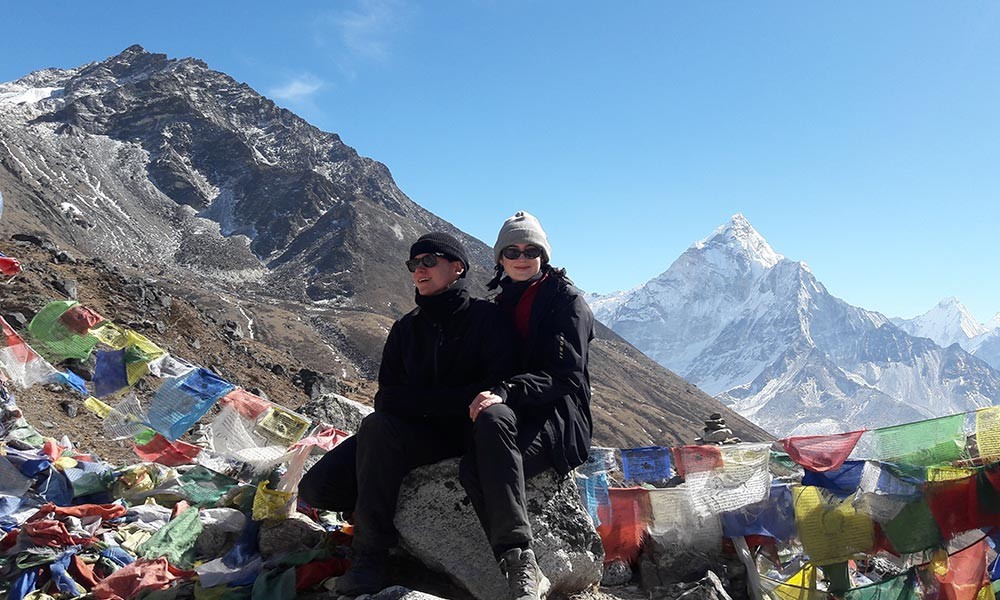
The Difficulty level of the Trek in May
The various difficulties of the trek include altitude sickness, challenging uphill climbs, rugged terrain, etc. Read further to learn about these difficulties in detail:
Altitude sickness
Altitude sickness is possibly the most significant threat for trekkers during this high-altitude trek. It gets caused due to the rapid change in altitude during their short tour. The trekkers will arrive at an altitude of above 4000m from the capital city of Kathmandu, lying at 1400 m.
Trekkers will not have proper time to adapt to these changing conditions actively. This will cause altitude sickness among trekkers. One aspect of tackling altitude sickness in the region is acclimatization. Acclimatization is one of the most preferred ways of exploring the area while adapting to the changes.
This process must get accompanied by regular hydration of around 3-4 liters of water. Trekkers should not trek for more than 6-7 hrs and 600 meters in altitude. Besides, walking gently and not racing through them is also quite helpful.
Rugged and remote rails
One of the various challenges you will face during this trek is quite rugged and remote terrains. The trails of these high-altitude treks such as EBC Trek and Everest Three High Passes Trek, pass through the Himalayan foothills. Therefore, it goes to remote areas that require extreme physical fitness and stamina from the trekkers. Besides that, you must also need mental stability to complete this trek. A positive attitude also helps them in even the most challenging conditions.
Long duration trek
The trek to EBC is a long journey that requires trekkers to walk for around 5 to 6 hours a day. Trekkers will have difficulty maintaining their steps with a professional trekking guide. However, if you train well ahead of the trek and keep your body fit, you can complete it without any hassle.
Accommodations
Accommodations are another part that trekkers might find difficult. Trekkers will stay in accommodations like tea houses, lodges, and guesthouses with basic meals and stay facilities. These accommodations will provide you with the essential facilities, including a bed and a blanket. While not fancy, these accommodations are ideal in high altitude conditions, and hence you will need to manage during the trek.
Why Take This Everest Base Camp Trek in May?
Incredible adventure
The first reason for this EBC trek is the incredible opportunity to pass through the Himalayan foothills. The Himalayan foothills provide you with an adventure of a lifetime as you pass through uphill and downhill terrains.
Various natural diversities, including rivers, lakes, glaciers, waterfalls, and others. Trekkers should remain fit for the treks through various means possible.
Mesmerizing Himalayas
The Himalayan wonders are quite an appealing factor in this high-altitude trek. The Everest Base Camp trek in May will provide you with the best views of the Himalayan landscapes in the clear blue skies.
The region has other natural beauties, including vast grasslands, meadows, hills, valleys, cliffs, waterfalls, rivers, glaciers, etc. Trekkers can take numerous pictures of the mesmerizing beauty of the region.
Unique and diverse cultural trails
The unique cultural trails is another ideal reason why you should trek this trek. This incredible trek passes through some of the beautiful cultural settlements. Your professional guide will help you translate the local language. They will provide you with insights into the region's culture, heritage, and tradition. Trekkers can also celebrate local festivities during the trek.
Wildlife exploration
The wildlife exploration of the region's various rare and endangered species is another important aspect of the trek. There is multiple wildlife in the area, including Himalayan tahr, dance, snow leopards, black bears, etc. These wildlife animals come out of their hibernation in the peak seasons in May. Hence, this wildlife exploitation is one of the significant aspects of this trek.
Safe and comfortable trails
The Everest base camp trek in May is also appealing for trekkers because of the safer and comfortable trails. There are no such challenges related to weather, including heavy rainfall, heavy snowfall, avalanches, landslides, and others.
Hence, for this reason, trekkers will get to trek through relatively comfortable trails in this peak season of May. Besides that, trekkers will also get the best facilities of meal and accommodation in this season which is an exemplary aspect of this trek.
Things to Consider for the Everest Base Camp Trek in May
Acclimatization
Acclimatization is another dominant aspect of this trek in the Everest Base Camp region. There are various advantages of acclimatizing along the trail as it will help you adapt to the low oxygen and low air pressure conditions. It also allows you to immensely tackle altitude sickness along the path.
There are two points in this trek where you can rest and acclimatize: Namche Bazaar and Dingboche. There you can explore the beautiful local settlements and have the opportunity to go on a cultural exploration. There you can observe the snow-clad mountains of the Everest Mahalangur region.
Guides or porters
Trekkers guides are essential aspects of any higher altitude region trek. Professional trekking guides will help you navigate along the trail. They will also keep you safe from various challenges as they are well versed in safety protocols and first aid facilities.
They will find the best accommodation and handle emergency conditions. Porters are significant as well as they will take your luggage to the destination ahead. This way, you can only take a backpack for a hassle-free trek.
Physical fitness and training
There are various physical fitness requirements for trekkers taking this trek. Trekkers must have multiple training sessions before this trek. Physical exercises, cardiovascular exercises (aerobics), and mental exercise are essential.
Training is necessary for the walk as it will help you with the various challenging conditions on this trek. Besides that, trekkers can also take various short hikes as practice for the journey.
Trekking gears and equipment
Trekkers should consider this aspect before starting their incredible journey. Trekking gears, including clothes and various equipment like poles, crampons, shoes, etc., are essential for the way. These trekking equipment are also available for hire from multiple shops around Kathmandu. These make the trekking experience at a high altitude.
Trekking insurance
Trekking insurance helps you remain covered by various challenges and risk factors. The various risk factors include injuries, accidents, altitude sickness, property loss, property theft, etc. Even a tiny cramp in this trekking journey can cause a big challenge. Hence, travel insurance provides you with essential coverage for the trek.
.jpg)
Meals and Accommodation in this Trek
The food and accommodation provided on the trail will satisfy the trekkers. While you can not expect anything fancy, the tea houses will provide you with ideal facilities for your stay. They provide you with a warm bed with blankets and other amenities required. They are also to get lunch and dinner twice a day.
There are also other lodges, guest houses, and even hotels in the lower region of this trail. However, if you reach a high-altitude area, you will experience a decrease in accommodation facilities and quality. This is understandable considering the trial's remoteness and the rise in transportation costs.
In these teahouses, the daily use toiletries need to get carried by the trekkers themselves. Another thing is that the toilet facilities are of squat style. This means you will have to face some difficulties, mainly if you are not accustomed to them. An extra sleeping blanket will always come in handy, especially if you are trekking in the off-season.
The temperatures drop significantly, and the climate remains unpredictable in these high-altitude terrains. The food along the trail generally includes the Nepalese dish of Dal Bhat. It is famous for providing trekkers with a healthy diet. A completely balanced diet contains all the nutrients required.
There are rice, vegetables, lentils, cereal, or pulses, along with other varieties of pickles. For breakfast, you will generally get hot beverages like soup, tea, coffee, along with bread and eggs. You can also get different tea varieties, including mint tea, rhododendron tea, and butter tea.
Besides that, trekkers must carry snacks like energy drinks, protein bars, and chocolates. They will not let you remain hungry and help you get instant energy while trekking the challenging conditions. A large quantity of water in a bottle is another requirement. Trekkers need to remain hydrated throughout their journey to avoid altitude sickness. You can carry water purification tablets and chlorine solutions to purify the water for drinking.
A Typical Day in the Trekking Journey
The trekking journey starts with the incredible Himalayan sunrise from the tea house viewpoint. From there, you will perform your daily early morning rituals and have a delicious breakfast. After having a fulfilling breakfast, you will pass through the most challenging landscapes.
You will start your trek at around 7-8 A.M and then continue before resting at the tea house, where you will also have your lunch. You will have various resting points since you need to keep your energy high and body fit. The region's incredible, adventurous, and scenic viewpoints will make sure you fall in love.
You can also trek gently and explore around and take fantastic pictures during your walk. There are various cultural monuments and landmarks in the region. You can gain unique cultural insight into the area and dwell upon its outstanding beauty there. You will then continue trekking before you arrive at the destination. There, you can rest and have some light snacks.
At around 8 P.M., you will have your dinner. There, you can socialize with fellow trekkers or read a book. Dal Bhat is a common Nepalese dish in these tea houses. You can also enjoy singing, dancing, and exchanging notes about the adventure with fellow trekkers. You can rest for the night in a small room of the teahouse with warm blankets and sleeping bags.
Why Do We Need to Trek with a Guide?
The trek is ideal both solo and with guides. However, if you trek with a professional guide, you will have a less challenging and comfortable journey. The trail then leads you to some uphill terrains, and you will encounter altitude sickness. A professional guide will help you navigate these rugged, rough terrains.
Moreover, you will remain protected from any external factors. These guides will also help you with accommodation, meals, and other logistics. These professional guides also know about the trekking routes in detail. Trekkers will pass through the cultural settlements passing through the beautiful heritage and landmarks.
The experienced guides will provide you with knowledge about the various aspects of the trails. This way, you will not offend the locals, and you will stay away from unwanted stuff in the area. Moreover, these trekking guides will help you with any case of altitude sickness, injuries, accidents, and others.
They also have first aid knowledge and use safety protocols in emergencies. Besides, the porters will help you with the luggage by taking it to the destinations in advance. Some porter guides who work as both will provide you with a great value of money with these porter guides.
How to train for the Trek?
The trek in the Everest region is quite strenuous. Multiple challenges will affect the trekkers' fitness. Hence, if you plan to take the Everest Base Camp trek in May or any other time, you should definitely consider training. A proper training regime will include all the fitness-building exercises like strength, endurance, flexibility training.
It must include cardiovascular exercises (aerobics) and other mental training as well. Mental stability gets often overlooked, but it is significant for the Trek. A trekker must remain positive and stable throughout their journey. You can start this training with a trainer or on your own a few weeks before going on this trek.
See more on: Everest Base Camp Trek Preparation
Essential Tips for the Everest Base Camp Trek in May
- Trekkers will need to hydrate well and acclimatize to tackle altitude sickness
- Get proper travel insurance before the trek
- Trekkers should carry snacks like chocolates and others to munch
- Get a professional trekking guide and porter
- Advance book all your meals and accommodations
- Trek gently with adequate rest in the middle
- Get appropriate trekking clothes and equipment required for this trek
- Prepare and pack well for the trek
- Get water purification tablets for drinking water
- Trek early to arrive at the destination in time
Packing List for the Everest Base Camp Trek in May
Clothing
- Trekking pants
- Down jacket
- Trekking shirts
- Warm woolen cap
- Waterproof jacket
- Windproof jacket
- Trekking socks
- Trekking boots
- Trekking gloves
- Thermal wears
- Raincoat
First Aid and Toiletries
- Anti-nauseant medication
- Insect repellent
- Water purifying tablets
- Shampoo
- Soap
- Toothbrush
- Toothpaste
- Quick-dry towel
- Sanitizer
- Toilet paper
- Sunscreen
Others
- Phone
- Power Banks
- Solar Charges
- Extra Batteries
- Local SIM card
- Reusable water bottles
- Trekking Map
- Camera
Important documents
The Final Say
Everest Base Camp Trek in May perfect trip in the Himalayan foothills. There are mostly sunny days with dry and warm conditions in this season. The trails also remain colorful, covered in wildflowers in May, the last month of Spring. The exciting mountain views and vibrant and colorful atmosphere of the region are highlights of the trek.
Besides that, you will also pass through the cultural settlements of the area. There are incredible Sherpa settlements, monasteries, gompas, chortens, and others along the path. Moreover, prayer flags, stones painted with ancient prayers will welcome you on this trail. Overall, the Everest Base Camp Trek in May is an incredible trip ideal for all travelers.
Our Everest trek guide for other months EBC Trek in September, Everest Base Camp Trek in October
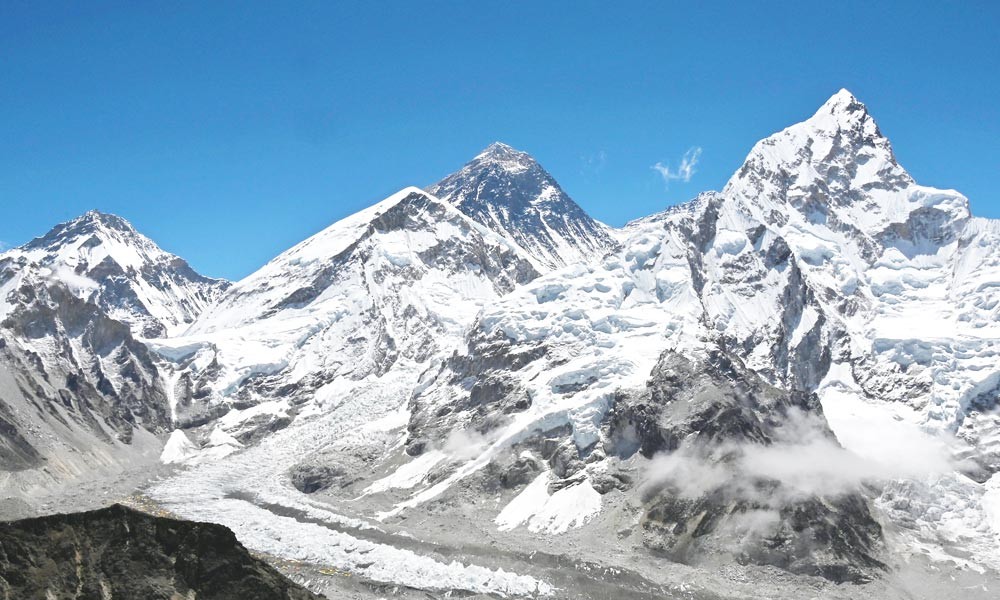





.jpg)
